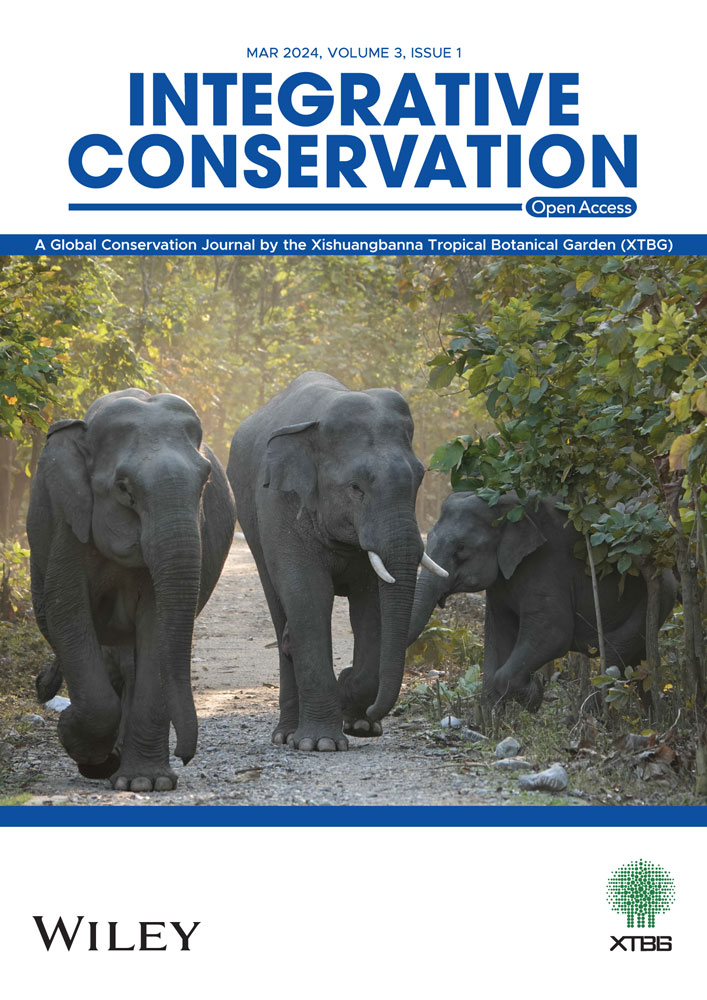Biophysical characteristics, distribution and conservation challenges of critically endangered Bhutan poppy (Papaver bhutanicum) in Jigme Dorji National Park, Bhutan
不丹吉格梅多吉国家公园中极度濒危的不丹罂粟(Papaver bhutanicum)的生物物理特征、分布和保护挑战
Editor-in-Chief: Ahimsa Campos-Arceiz Handling Editor: Harald Schneider
Abstract
enThe occurrence of certain rare plant species in specific ecological habitats is intricately linked to a myriad of environmental conditions, encompassing both biotic and abiotic factors. The prioritisation of monitoring efforts becomes more impactful when conservationists possess a comprehensive understanding of the ecology and distribution of rare species within their designated habitats and across the entire range of the species. In September 2023, a study was conducted in Jigme Dorji National Park to assess the ecology, distribution and threats to the critically endangered Bhutan poppy. This survey, employing random sampling, covered approximately 87 ha across Tshophu, Tshophu base and Jichudrakey base in Soe Gewog and analysed 202 2 × 2 m plots. The survey revealed 57 plant species from 24 families, with Asteraceae (17.5%) and Papaveraceae (12.3%) dominating. Notably, 46% of families comprised a single species, and significant species richness differences were observed between Tshophu, Tshophu base and Jichudrakey base. Correlations between species richness and environmental variables, including slope, rock cover (%), bare soil cover (%) and herb cover (%), were identified as significant. The Bhutan poppy was positively and significantly associated with the southwest aspect, occupying 59% of surveyed plots. Species distribution modelling predicted a distribution area of approximately 37.29 square kilometres within the national park. However, future climate scenarios indicated a significant shift in the distribution of the Bhutan poppy. By 2041–2060, there is an anticipated decrease of 33% in its distribution area, with a shift towards the northeast. In the period from 2061 to 2080, the distribution is expected to increase by 8% from its current range, maintaining the northeast shift. The study identified three primary threats: grazing, trampling and harvesting, with livestock activities prevalent in 92% of plots and signs of harvesting in 45%. These findings provide crucial insights into the ecological dynamics, distribution patterns and potential conservation challenges facing the Bhutan poppy in Jigme Dorji National Park's alpine habitats, emphasising the need for informed conservation strategies amidst changing environmental conditions.
摘要
zh某些珍稀植物物种在特定生态栖息地的出现与无数环境条件密切相关,包括生物因素和非生物因素。当保护工作者对稀有物种在其指定栖息地和整个分布区的生态和分布情况有了全面了解后,监测工作的优先次序就会变得更加有效。2023 年9月,在吉格梅多吉国家公园开展了一项研究,以评估极度濒危的不丹罂粟的生态、分布和面临的威胁。这项调查采用随机抽样的方式,覆盖了索悟(Soe Gewog)的梭布(Tshophu)、梭布基地(Tshophu base)和吉曲德基基地(Jichudrakey base)约87公顷的土地,分析了202个 2 ×2米的样方。调查发现了 24 个科的 57 种植物,其中以菊科(17.5%)和罂粟科(12.3%)为主。值得注意的是,46% 的科中只有一个物种,而且在Tshoph的高山流石滩、Tshophu基地和廷布Soe Gewog的Jichudrakey基地之间观察到显著的物种丰富度差异。物种丰富度与环境变量(包括坡度、岩石覆盖率(%)、裸土覆盖率(%)和草本覆盖率(%))之间存在显著相关性。不丹罂粟与西南坡向呈显著正相关,占据了 59%的调查样方。物种分布模型预测,不丹罂粟在国家公园内的分布面积约为 37.29平方公里。然而,未来气候情景表明不丹罂粟的分布将发生重大变化。到 2041–2060年,不丹罂粟的分布面积预计将减少33%,并向东北部转移。在 2061-2080年期间,不丹罂粟的分布范围预计将比目前增加8%,并保持向东北部转移的趋势。本研究识别出了三个主要威胁:放牧、践踏和采伐,其中92%的样方普遍存在牲畜活动,45% 的样方有采伐迹象。这些发现为了解不丹罂粟在吉格梅多吉国家公园高山栖息地的生态动态、分布模式和潜在保护挑战提供了重要信息,强调了在不断变化的环境条件下制定明智保护战略的必要性。【审阅:杨斌】
Plain language summary
enThe Bhutan poppy stands out as one of the world's rarest poppy species, exclusively confined to Jigme Dorji National Park. This rare plant thrives on the alpine screes of Tshophu, Tshophu base and Jichudrakey base under Soe Gewog in Thimphu Dzongkhag. This study identified environmental factors and other associated plant species coexisting with the Bhutan poppy within the altitudinal range of 4351–4494 m. Within this elevation range, 57 plant species across 24 families were identified, with species richness intricately linked to environmental variables such as slope, bare soil cover, rock cover and herb cover percentages. The Bhutan poppy predominantly grows on southwestern-facing slopes. Owing to its medicinal properties, local inhabitants harvest the entire plant for trade. However, alongside the practice of plant collection, the study identified additional threats posed by grazing and trampling from livestock, including horses, yaks and mules. To address these concerns, the study recommends raising awareness amongst local inhabitants regarding the potential consequences of harvesting the entire plant. Moreover, it emphasises the importance of concerted conservation efforts and community engagement as essential measures to preserve the existence of this rare and ecologically significant species.
简明语言摘要
zh不丹罂粟是世界上最稀有的罂粟属物种之一,仅分布在吉格梅多吉国家公园。这种珍稀植物生长在Tshophu的高山流石滩,Tshophu基地和Jichudrakey基地,位于廷布各宗(Thimphu Dongkhag)的索悟(Soe Gewog)下。本研究在4,351 - 4,494米的海拔范围内识别出了与不丹罂粟共存的环境因子和其他伴生植物物种。在该海拔范围内,共鉴定出24科57种伴生植物,物种丰富度与坡度、裸土盖度、岩石覆盖度和草本盖度等环境变量密切相关。不丹罂粟主要生长在西南坡。由于其药用价值,当地居民采收整株植物进行售卖。然而,除了植物被采集所面临的主要威胁外,研究还发现了马匹、牦牛和骡子等牲畜的放牧和践踏造成的额外威胁。为了解决这些问题,研究建议提高当地居民对采摘整株植物的潜在后果的认识。此外,研究还强调了协同保护和社区参与的重要性,认为这是保护这一具有重要生态意义的稀有物种的重要措施。
Practitioner points
en
-
Jigme Dorji National Park is the sole habitat for the critically endangered Bhutan poppy, both in Bhutan and globally, confined to the alpine screes of Tshophu, Tshophu base and Jichudrakey base in Soe Gewog, Thimphu.
-
The majority of Bhutan poppy occurrences are in southwest aspects, where they face threats from harvesting, grazing and trampling by livestock.
-
Effective conservation of this rare and endemic species necessitates raising awareness amongst local communities about the responsible collection of the Bhutan poppy, actively involving them in its preservation.
实践者要点:
zh
-
吉格梅多吉国家公园是不丹乃至全球极度濒危的不丹罂粟的唯一栖息地,仅限于Tshoph的高山流石滩、Tshophu基地和廷布(Thimphu) 索悟(Soe Gewog)的Jichudrakey基地。
-
不丹的罂粟大部分分布在西南坡,面临着采伐、放牧和牲畜践踏的威胁
-
有效地保护这种珍稀和特有种,需要提高当地社区负责任地采集不丹罂粟的认识,并积极参与其保护。
1 INTRODUCTION
The genus Meconopsis, commonly known as Himalayan or blue poppies, is a group of herbaceous alpine ecosystem plant species native to the Himalayas. This diverse genus comprises over 70 species within the Papaveraceae family (Xiao & Simpson, 2017). Bhutan is a habitat for more than 18 Meconopsis species, including the notable Meconopsis gakyidiana (Tosh. Yoshida, Yangzom and D. G. Long, 2017), which holds significance as the country's national flower. Previously, this species was misidentified as Meconopsis grandis (Prain, 1896).
Amongst the 18 Meconopsis species found in Bhutan, Papaver bhutanicum (Yoshida & Grey-Wilson, 2012), formerly known as Meconopsis bhutanica, is particularly significant due to its rarity, endemic nature and status as a critically endangered species (International Union of Conservation of Nature and Natural Resource [IUCN], 2017; Yoshida & Grey-Wilson, 2012). This Bhutan poppy is confined to Jigme Dorji National Park (JDNP), around Tshophu Lake. Initially classified as a subspecies of Meconopsis discigera in 1995 (Prain, 1906), it was not until 2012 that the species was accurately identified as a distinct entity (Yoshida & Grey-Wilson, 2012). Characterised by its extremely limited distribution range, the Bhutan poppy has been documented in a few specific locations, such as Barshong (potentially referring to Yaklela), Bongtela and Tshophu (Yoshida & Grey-Wilson, 2012).
Alpine ecosystems thrive beyond the treeline, exhibiting remarkable richness in plant ecosystems (Korner, 2002). In the Himalayas, these ecosystems boast abundant native and endemic biodiversity, providing a habitat for numerous specialised and geographically range-restricted species (Chettri et al., 2010; Dhar, 2002). However, these ecosystems are also amongst the most vulnerable and sensitive to the impacts of land use and climate change, primarily due to the temperature limitations that influence species survival (Huber et al., 2013; Vanneste et al., 2017). With global warming, there is an anticipated upward movement of species from lower elevations into alpine and subalpine environments. This shift poses significant threats, potentially resulting in habitat shrinkage, increased risk of cryophilic plant extinction, disruption of current species composition and effects on both physical and biological environmental conditions (Beniston, 2003; Parmesan & Yohe, 2003; Pauli et al., 2003; Wiens, 2016). Rare species that have a restricted distribution range and are native to alpine regions face a higher risk of extinction due to limited opportunities for upward migration.
Ecologists use various criteria to define species rarity, with certain rare species exhibiting variability in their local presence. A species might be widely distributed but rare in specific locations, locally abundant but with restricted distribution or scarce in specific localities despite a broad geographic range (Rabinowitz, 1981). The rarity of certain species is intricately linked to their life history traits, such as dependency on disturbances or specific pollinators (Bissessur et al., 2019; Kaye et al., 2001). Rare species play a disproportionate role in contributing to regional community diversity (Chapman et al., 2018). They significantly enhance ecosystem functioning, often in ways that cannot be substituted by a more common species (Winter et al., 2013). Rarity extends beyond numerical abundance or spatial extent; it encompasses the unique ecological roles these species play in their environments (Winter et al., 2013). Increasingly rare and endemic plant species such as the Bhutan poppy warrant special conservation concern as they are more susceptible to disturbances, thereby facing a higher risk of extinction (Coelho et al., 2020; Gaston, 1998).
The objectives of this study were as follows: (1) identify and document different growing sites of the Bhutan poppy; (2) assess and catalogue floristic composition in the Bhutan poppy growing sites; (3) investigate environmental variables affecting the growth of the Bhutan poppy; (4) predict the potential distribution of the Bhutan poppy in JDNP; and (5) assess anthropogenic threats to Bhutan poppy conservation. The anticipated results aim to significantly contribute to informed management and conservation strategies for the Bhutan poppy within the national park.
2 MATERIALS AND METHODS
2.1 Study area
The research was carried out at three distinct sites within JDNP: Tshophu, Tshophu base and Jichudrakey base, located in Soe Gewog, Lingzhi Dungkhag, Thimphu Dzongkhag (Figure 1). JDNP, spanning from 27°33′ N–28°15′ N to 89°14′ E–90°22′ E, is the second-largest of Bhutan's 11 protected areas, inclusive of the Royal Botanical Park, covering an extensive area of 4374.06 square kilometres. The park is renowned for its diverse altitudinal gradient (1200–>7000 m), its representation of the upper Himalayan ecosystem and the Palaearctic biogeographic realm and its rich biodiversity (Dendup, Dorji, Jamtsho, Wangchuk, Tshering et al., 2021). The park experiences four distinct seasons (winter, spring, summer and autumn) and is characterised by five different forest types, including subtropical forests, warm temperate forests, cool temperate forests, cold temperate forests and rhododendron scrubs.
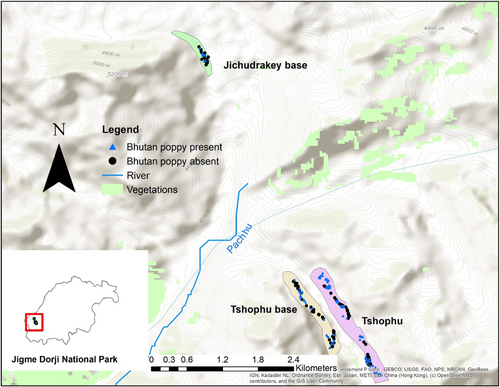
Additionally, JDNP is the origin of four major rivers—The Pachu, The Wangchu, The Phochu and The Mochu—contributing significantly to the country's water resources and hydropower. The Pachu originates from within the study area. The park's rich biodiversity includes over 1434 vascular plants, 50 mammal species, 414 birds, 22 reptiles, 15 amphibians, 87 butterflies and 17 species of dragons and damselflies (Dendup, Dorji, Jamtsho, Wangchuk, Tshering et al., 2021). The national park is home to more than 5000 residents across 138 villages. The park's importance is further accentuated by its role as a habitat for eight species of blue poppies, including the critically endangered M. bhutanica (Papaver bhutanicum) (Figure 2), alongside M. horridula (Hook. f. & Thomson, 1855), M. bella (Prain, 1894), M. simplicifolia (D. Don/G. Don, 1831), M. primulina (Prain, 1896), M. paniculata (D. Don/Prain, 1896), M. villosa (Hook. f/G. Taylor, 1934) and M. sherriffii (G. Taylor, 1937).
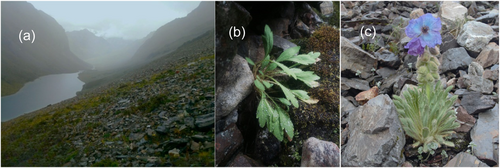
2.2 Site selection and survey design
The site selection process for the Bhutan poppy survey was conducted systematically with guidance from prior surveys, such as the national snow leopard survey, rapid biodiversity survey, insights from SMART patrolling activities, interviews with local herders and secondary published data. Following the identification and selection of study sites, the Area of Occurrence (AOO) was delineated using Google Earth, creating a polygon map to define the survey area. Within this AOO, three independent sampling sites were chosen, each measuring 12, 29.7 and 44.5 ha, respectively. Centroid points for 2 × 2 m survey plots were generated within the AOO using ArcGIS v.10.8.2 (ESRI, 2021). The spatial coordinates of these points were uploaded to a GPS unit for on-site navigation and to accurately lay out plots (2 × 2 m) for data collection.
2.3 Data collection
In September 2023, survey plots in the three identified study sites were located using GPS. Within each survey plot (2 × 2 m), a comprehensive assessment was conducted, counting all plant species, including the Bhutan poppy. Cover percentages and counts of each species were measured and documented. Biophysical variables such as elevation, aspect, slope, herb cover percentage, shrub cover percentage, rock cover percentage and bare soil cover percentage were measured and recorded.
2.4 Data analysis
2.4.1 Species diversity and environmental variables in the study site
All analyses were performed using the statistical software R v.4.3.2 (R Core Team, 2023).
The ‘vegan’ package (Oksanen et al., 2022) was employed for species community analysis to assess species diversity (richness and abundance). The Shannon diversity index was calculated for each site to compare species diversity, again using the ‘vegan’ package. Additionally, one-way analysis of variance was applied to analyse differences in the mean of species present at each site. The ‘iNEXT’ package (Hsieh et al., 2022) was employed to gauge the completeness of the sampling.
2.4.2 Bhutan poppy habitat preference and threat influence analysis
Logistic regression with binomial distribution was performed to model Bhutan poppy presence and absence data as a function of environmental covariates (File SI), utilising the ‘arm’ package (Gelman & Su, 2022). To determine the best-fit model, multimodel inferences were conducted, selecting the candidate model with the lowest Akaike's information criterion corrected. This methodology was similarly employed to analyse the impact of threats on the growth of the Bhutan poppy.
2.4.3 Bhutan poppy distribution modelling
Species distribution modelling was performed using the ‘dismo’ package (Hijmans et al., 2023), the ‘raster’ package (Hijmans, 2023) and the ‘sdm’ package (Naimi & Araujo, 2016). The modelling utilised a data set of 114 occurrence points for Bhutan poppy and 570 pseudoabsent points (maintaining a 1:5 presence–absence ratio). The data set incorporated 19 bioclimatic variables, each with a spatial resolution of 30 arc-sec (approximately 1 km at the equator), representing current climatic conditions (averaged for 1950–2000) (Booth et al., 2014), sourced from the WorldClim data set (https://www.worldclim.org). Additionally, three topographic variables—elevation, slope and aspect—were included, derived from a digital elevation model with a resolution of 12.5 m.
To improve prediction accuracy and manage multicollinearity, Pearson's correlation analysis was conducted on all environmental variables. The variables with variance inflation factor (VIF > 10) were regarded as highly correlated and subsequently omitted from further analysis (Montgomery et al., 2012; Zuur et al., 2009). Seven variables with VIF < 10 were retained (File SII), while 15 variables with VIF > 10 were excluded.
For distribution modelling, two approaches were tested: a generalised linear model (GLM) and a generalised additive model (GAM). The GAM outperformed the GLM, as indicated by its superior results: area under curve = 1, Correlation = 0.98, True skill statistic (TSS) = 1 and Deviance = 0.15. Consequently, GAM was selected to generate the final distribution map.
Future distribution projections for the Bhutan poppy, for the Years 2041–2060 and 2061–2080, utilised climate models. These projections were based on the general circulation model (GCM) MPI-ESM1-2-HR and the global CO2 emission scenario of ssp245 (~2.5 to ~3 CO2 emissions from preindustrial baseline till 2100, with an expected decline by 2045). The GCM MPI-ESM1-2-HR is recognised as one of the most suitable models for the Indian subcontinent (Thakur & Manekar, 2023).
3 RESULTS
3.1 Species diversity and environmental variables in the study site
A total of 202 plots, each measuring 2 × 2 m, were surveyed across three distinct sites: Tshophu, Tshophu base and Jichudrakey base. The sites were situated at altitudes ranging from 4351 to 4494 m, with a mean of 4418 m (SD = 24.7). Amongst these plots, nine were situated on rocky scree devoid of vegetation cover and were consequently excluded from the analysis. The descriptive statistics for both the species data and environmental variables are detailed in Table 1. In the remaining 193 plots, the presence of the Bhutan poppy and other alpine plants was documented in two primary habitats: Alpine scree and Alpine meadow.
| Habitat | Minimum | Maximum | Mean ± SD |
|---|---|---|---|
| Alpine scree (n = 188) | |||
| Environmental variables | |||
| Elevation (m) | 4310 | 4553 | 4406.5 ± 55.3 |
| Slope (deg) | 15 | 50 | 33.6 ± 6.4 |
| Aspect (deg) | 0 | 355 | 182.9 ± 93.3 |
| Rock cover (%) | 10 | 99 | 85 ± 18.3 |
| Bare soil cover (%) | 0 | 60 | 4.8 ± 9.8 |
| Shrub cover (%) | 0 | 30 | 1.2 ± 4.3 |
| Herb cover (%) | 0 | 70 | 8.8 ± 10.2 |
| Species richness and abundance | |||
| Richness | 1 | 10 | 3.8 ± 1.6 |
| Abundance | 1 | 170 | 44.4 ± 34.1 |
| Alpine meadow (n = 5) | |||
| Environmental variables | |||
| Elevation (m) | 4335 | 4474 | 4410.8 ± 53.0 |
| Slope (deg) | 0 | 39 | 23.4 ± 16.1 |
| Aspect (deg) | 25 | 353 | 137 ± 153.1 |
| Rock cover (%) | 0 | 40 | 22 ± 16.4 |
| Bare soil cover (%) | 0 | 65 | 30 ± 28.5 |
| Shrub cover (%) | 0 | 40 | 8 ± 17.9 |
| Herb cover (%) | 5 | 100 | 40 ± 40.5 |
| Species richness and abundance | |||
| Richness | 3 | 5 | 4.2 ± 1.1 |
| Abundance | 84 | 151 | 110.2 ± 27.3 |
A total of 57 alpine plant species were documented during the survey, averaging 3.8 species per plot (SD = 1.5) and a total abundance of 8905 individuals (Tshophu = 5869, Tshophu base = 2066 and Jichudrakey = 970), with a mean of 42.3 individuals per plot (SD = 35.5). These plants belonged to 24 different families, with Asteraceae being the most prevalent (17.5%), followed by Papaveraceae (12.3%). Notably, 46% of the families comprised only one species.
In terms of species distribution, Tshophu exhibited higher species richness and abundance compared to Jichudrakey base and Tshophu base (Figure 3). Species richness was positively and significantly correlated with slope (p = 0.001), rock cover (%) (p = 0.049), bare soil cover (%) (p = 0.045) and herb cover (%) (p = 0.037), while the species abundance was positively and significantly correlated to slope only (p = 0.007).
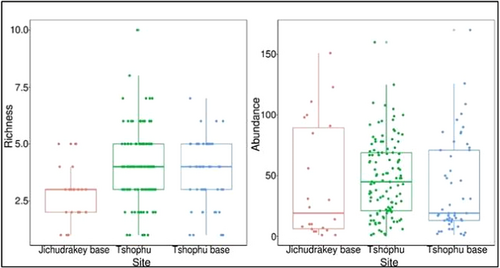
A significant difference in species richness was observed between Tshophu and Jichudrakey base (95% confidence interval [CI] = 0.589–2.306, p = 0.000), as well as between Tshophu base and Jichudrakey base (95% CI = 0.335–2.242, p = 0.004). However, the difference in species abundance across study sites was nonsignificant (p = 0.350).
The diversity analysis revealed that Tshophu site exhibited the highest species diversity with a Shannon diversity index (H') of 1.00, followed by Tshophu base (H' = 0.95) and Jichudrakey base (H' = 0.76). Despite the relatively high species diversity indices across the study sites, the species richness accumulation curve suggests that the survey effort was not exhaustive (Figure 4 and Table 2).
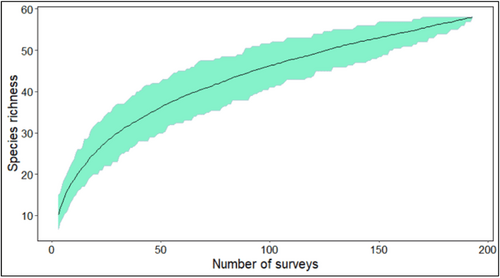
| Site | Sample size | Completeness |
|---|---|---|
| Jichudrakey base | 22 | 0.941 |
| Tshophu base | 51 | 0.959 |
| Tshophu | 120 | 0.967 |
The observed sampling shortfall in the study indicates an incomplete representation of species diversity within the surveyed areas. Specifically, a shortfall of approximately 6% at Jichudrakey base, about 4% at Tshophu base and roughly 3% at Tshophu (Table 2). To address this, extrapolating species richness to the asymptote provides a more comprehensive estimate of species diversity for each study site. The results of this extrapolation are detailed in Table 3.
| Estimate | Standard error | ||||
|---|---|---|---|---|---|
| Site | Extrapolated richness | 2.5% | 97.5% | 2.5% | 97.5% |
| Jichudrakey base | 15 | 16.99 | 18.81 | 1.43 | 2.35 |
| Tshophu base | 27 | 30.6 | 34.84 | 1.76 | 3.1 |
| Tshophu | 43 | 49.43 | 58.86 | 2.39 | 4.65 |
3.2 Bhutan poppy habitat and threats in the study site
The presence of the Bhutan poppy was observed in 59% of the surveyed plots (114 out of 193), amounting to 208 individual sightings. There was a statistically significant (p = 0.043) and positive correlation in relation to aspect (β = 3.784, SE = 1.871, 95% CI = 1.121–7.483), with the southwest aspect hosting the majority of Bhutan poppy presence.
The study sites also revealed three distinct threats to this species: grazing, trampling and harvesting. Grazing and trampling, mainly attributed to yaks, mules and horses, were documented in the majority of sites (92%, 178 out of 193), whereas signs of harvesting were observed in 45% of the sites (86 out of 193). Despite these threats, their presence in the study site did not show a significant influence on the presence of the Bhutan poppy; grazing (β = 1.3863, SE = 1.620, 95% CI = −2.103 to −4.943), harvesting (β = 20.643, SE = 1156.12, 95% CI = −16.256 to −470.080) and trampling (β = −1.029, SE = 1.433, 95% CI = −4.285 to −2.225).
3.3 Bhutan poppy current and future distribution in JDNP
Under the current climate conditions, the species distribution model for the Bhutan poppy revealed approximately 37.29 square kilometres of suitable habitat within JDNP. However, future climate projections for the Years 2041–2060, based on the ssp245 climate scenario, anticipate a decline of approximately 33% in this distribution area, with a shift towards the northeastern part of the national park. Intriguingly, the climatic model for the period 2061–2080, also under ssp245, suggests an 8% increase in distribution area, with the shift maintaining its direction towards the northeast (Figure 5).
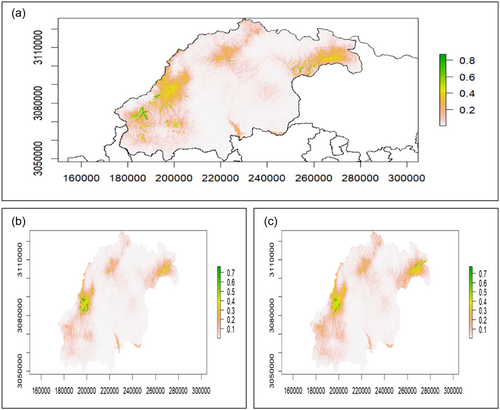
4 DISCUSSION
The exploration of species distribution, including that of the Bhutan poppy, is subject to diverse factors, encompassing inadequate species records, restricted empirical data, sampling biases and variations in sampling techniques. The intensity of sampling is anticipated to fluctuate, with easily accessible areas often acknowledged for their diverse species richness (Joshi & Joshi, 2021; Ladle & Hortal, 2013).
The Bhutan poppy, classified as a rare and critically endangered species (IUCN, 2017), lacks comprehensive information about its distribution and occurrence. The Bhutan poppy was only identified in 2012 as a distinct species from M. discigera (Yoshida & Grey-Wilson, 2012). Historical knowledge suggests its presence in specific locations within Lingzhi Dungkhag, namely, Barshong, Bongtela, Tshophu and Yaklela (Yoshida & Grey-Wilson, 2012). In the recent survey, aside from the Tshophu area, the presence of the Bhutan poppy was noted at the Jichudrakey base and Tshophu base, although it was not found in Bongtela. Due to logistical constraints, its presence in Yaklela and Barshong could not be verified either.
The richness and abundance of plant species exhibited a stronger correlation with physical environmental factors like slope, rock cover and bare soil cover rather than with biological environmental factors. This contradicts findings from other studies, which highlighted different influencing factors (Dorji et al., 2018; Kaarlejarvi & Olofsson, 2014; Meineri et al., 2012). Both richness and abundance responded positively to physical environmental variables, possibly influenced by microclimate heterogeneity. Steeper slopes and increased rock cover may enhance exposure to sunlight, wind and moisture, influencing soil moisture and drainage, critical factors for alpine plant adaptation (Bliss, 1962). At higher elevations, where moisture content is reduced, there is a noticeable decrease in species evenness compared to lower elevations (Dorji et al., 2016).
The presence of the Bhutan poppy was significantly associated with aspect (southwest), consistent with other studies (Winkler et al., 2016). It is well-documented that in the Northern Hemisphere, plant diversity tends to be higher on east and south-facing slopes. These aspects provide a warmer microclimate compared to northern slopes at similar elevations, primarily due to greater sunlight exposure, which facilitates plant growth (Perring, 1959). This aspect-related preference is also observed in the Bhutan poppy growing, especially in the Tshophu area, which is known to receive more sunlight (Yoshida & Grey-Wilson, 2012).
The Bhutan poppy, recognised as a critically endangered plant species by the IUCN (2017), holds a distinct classification as a Schedule II species under the Forest and Nature Conservation Act of Bhutan 2023 (FNCA 2023) (RGoB, 2023). The IUCN defines a species as critically endangered when there is a reduction in population size of ≥90% over the previous 10 years or three generations (IUCN, 2012). This study identified three primary threats within the study area: grazing, trampling and harvesting. Grazing and trampling by yaks, horses and mules were found in 92% of the surveyed plots, while signs of harvesting were observed in 45% of the plots. Similar conservation threats were reported in the Jigme Khesar Strict Nature Reserve in a study on the white poppy (M. superba, Prain 1896) (Wangyal et al., 2023). The livelihood of the people in Soe Gewog revolves around yak rearing and the transportation of goods, with the area housing approximately 2186 livestock (yaks, horses and mules) (Dendup, Dorji, Jamtsho, Wangchuk, Gyeltshen et al., 2021). The grazing of these livestock in the Bhutan poppy habitat inevitably leads to trampling, which can be devastating for these rare plants. Trampling has a detrimental impact on plant survival, causing damage to reproductive parts and potentially resulting in reproductive arrest. Given the monocarpic nature of the Bhutan poppy (Yoshida & Grey-Wilson, 2012)—completing its life cycle within 1 year and flowering and seeding only once (Kiefer et al., 2019)—any damage to these plants can be particularly consequential. The slow regeneration rate of the species, combined with the potential for complete reproductive failure due to trampling, underscores the need for urgent conservation measures to protect this rare and ecologically significant species.
Beyond ecological concerns, the Bhutan poppy is also valued for its medicinal properties, with people reportedly collecting the entire plant. The utilisation of medicinal plants is a crucial aspect of human reliance on biodiversity, providing essential benefits (Hamilton, 2004). However, overharvesting poses a significant threat to these valuable species, potentially leading to genetic loss and jeopardising their survival (IUCN, 1993).
The distribution of biodiversity is anticipated to be impacted by climate change, acting in conjunction with human-induced stressors like changes in land use, land fragmentation and degradation (Diffenbaugh & Field, 2013). Accurately predicting the impact of climate change on the habitats and geographic ranges of species of conservation concern is crucial (Kearney & Porter, 2009). In the current climate scenario, the suitable area for Bhutan poppy is 37.29 km2. However, the future climate scenario (2041–2060) predicts a loss of about 33% of its distribution area, with a northward shift in its range. This aligns with studies reporting a decline in plant species richness from the equator to the poles due to climate change (Willig et al., 2003), particularly affecting alpine and arctic ecosystems (Hansen et al., 2001; Kittel et al., 2000). Interestingly, for the more distant future climate scenario (2061–2080), there is an anticipated 8% increase in Bhutan poppy distribution from its current range. The observed increase in the distribution range of the Bhutan poppy in this future climate scenario (2061–2080) can be ascribed to the utilisation of the same GCM (MPI-ESM1-2-HR) and the ssp245 global CO2 emission scenario. This scenario forecasts a decline in carbon emissions by 2045. As 2080 approaches, the climate is anticipated to be comparatively cooler than in 2060, leading the model to project an expansion in species distribution range.
While an increase in suitable areas by the year 2061 is projected, the Bhutan poppy may experience more disturbances. The future habitat projection for the Bhutan poppy encompasses regions within JDNP, such as Laya, Lingzhi and Lunana. These areas stand out for their considerably higher human and livestock populations when compared to Soe, the current location of the Bhutan poppy. Notably, Lingzhi boasts a human population of 440, Lunana 812 and Laya 1090, in contrast to Soe's 219 individuals. Similarly, predicted livestock numbers are significantly higher in these projected areas: Lingzhi at 4249, Lunana at 4283 and Laya at 5832, all surpassing Soe's 2186 livestock (Dendup, Dorji, Jamtsho, Wangchuk, Gyeltshen et al., 2021). Given the anticipated growth in both human and livestock populations, the Bhutan poppy's survival prospects in this future scenario appear challenging, with an expected escalation in threats to its existence.
5 CONCLUSION
This study represents the first focused research on the rare and critically endangered Bhutan poppy (P. bhutanicum) and its associated plant species. Our investigation underscores the sparseness of Bhutan poppy distribution within a highly restricted range, confined to an area of <87 ha. To gain a more comprehensive understanding of its presence, further exploration is warranted, particularly in areas historically mentioned by Yoshida and Grey-Wilson (2012) and potential new locations like Gunglung in Soe Gewog. In the absence of Bhutan poppy sightings in these additional areas, it would be prudent to upgrade its conservation status in Bhutan from Schedule II to Schedule I in the FNCA 2023. Such an elevation would afford the species enhanced protection, acknowledging its ecological significance.
Despite their numerical scarcity, restricted range and fragile habitats, rare plants such as the Bhutan poppy play pivotal roles in ecosystems. Each species, with its distinct role, contributes to maintaining ecological balance and functionality. The loss of a rare plant can disrupt intricate ecological interactions, potentially triggering cascading effects throughout an ecosystem. Furthermore, rare plants contribute to the aesthetic allure of natural landscapes, rendering them valuable for ecotourism and recreational purposes.
Given the vital ecological functions performed by rare plant species, particularly the Bhutan poppy, there is an urgent imperative to conserve this critically endangered alpine plant. While challenges like habitat loss due to climate change may be beyond immediate control, our focus should pivot towards raising awareness amongst local communities about the potential repercussions of harvesting the entire plant. Through concerted conservation efforts and community engagement, we can strive to safeguard the existence of this rare and ecologically significant species.
AUTHOR CONTRIBUTIONS
Pema Dendup: Conceptualisation; methodology; investigation; formal analysis; project administration; software; visualisation; writing—original draft; writing—review and editing). Pema Kuenzang: Investigation; data curation; writing—review and editing. Tandin Dorji: Investigation; writing—review and editing. Wangchuk Wangchuk: Data curation; writing—review and editing.
ACKNOWLEDGEMENTS
We extend our gratitude to the Chief Forestry Officer of Jigme Dorji National Park for approving our plan and granting permission for our research within the national park. Special thanks to the editor and the three anonymous reviewers for their invaluable feedback, which significantly contributed to shaping our manuscript. Funding for this research was provided by the Bhutan For Life and Royal Government of Bhutan.
CONFLICT OF INTEREST STATEMENT
The authors declare no conflicts of interest.
Open Research
DATA AVAILABILITY STATEMENT
Since the data belongs to the Jigme Dorji National Park, we do not have permission to upload the data in the public domain.



